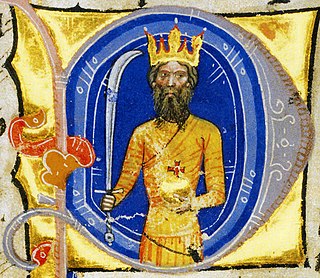
This is a list of Huns (a Central Asian people who lived in Europe between the 4th and 6th centuries AD) and of people of Hunnish descent, sorted by field and name:

This is a list of Huns (a Central Asian people who lived in Europe between the 4th and 6th centuries AD) and of people of Hunnish descent, sorted by field and name:
This section possibly contains original research .(June 2023) |

Attila, frequently called Attila the Hun, was the ruler of the Huns from 434 until his death, in March 453. He was also the leader of an empire consisting of Huns, Ostrogoths, Alans, and Bulgars, among others, in Central and Eastern Europe.

The Huns were a nomadic people who lived in Central Asia, the Caucasus, and Eastern Europe between the 4th and 6th century AD. According to European tradition, they were first reported living east of the Volga River, in an area that was part of Scythia at the time; the Huns' arrival in Europe is associated with the migration westward of an Iranian people, the Alans. By 370 AD, the Huns had arrived on the Volga, and by 430, they had established a vast, if short-lived, dominion in Europe, conquering the Goths and many other Germanic peoples living outside of Roman borders and causing many others to flee into Roman territory.

Bleda was a Hunnic ruler, the brother of Attila the Hun.

Onegesius was a powerful Hunnic logades (minister) who supposedly held power second only to Attila the Hun. According to Priscus he "seated on a chair to the right of the king" i.e. Attila.

Priscus of Panium was a 5th-century Eastern Roman diplomat and Greek historian and rhetorician.
The Akatziri, Akatzirs or Acatiri were a tribe that lived north of the Black Sea, though the Crimean city of Cherson seemed to be under their control in the sixth century. Jordanes called them a mighty people, not agriculturalists but cattle-breeders and hunters. Their ethnicity is undetermined: the 5th-century historian Priscus describes them as ethnic Scythians, but they are also referred to as Huns. Their name has also been connected to the Agathyrsi. However, according to E. A. Thompson, any conjectured connection between the Agathyrsi and the Akatziri should be rejected outright. but the word Agathirsi, a Scythian tribe, is explained in Greek as "referring to the compound herbal wand of Bacchus. ", which matches the literal meaning of `ağaçeri` (woodman), a Turkish word. Today, `ağaçeri` are called tahtacı.
Ernak was the last known ruler of the Huns, and the third son of Attila. After Attila's death in 453 AD, his Empire crumbled and its remains were ruled by his three sons, Ellac, Dengizich and Ernak. He succeeded his older brother Ellac in 454 AD, and probably ruled simultaneously over Huns in dual kingship with his brother Dengizich, but in separate divisions in separate lands.
By the name Edeko are considered three contemporaneous historical figures, whom many scholars identify as one:

Kreka or Hereka was the wife of Attila. She was described by Eastern Roman diplomat Priscus in his account of his stay at Attila's court in 448 or 449 AD. She and Attila had three sons: Ellac, Dengizich, and Ernak, who split among themselves what remained of Attila's empire after his death in 453.
The history of the Huns spans the time from before their first secure recorded appearance in Europe around 370 AD to after the disintegration of their empire around 469. The Huns likely entered Western Asia shortly before 370 from Central Asia: they first conquered the Goths and the Alans, pushing a number of tribes to seek refuge within the Roman Empire. In the following years, the Huns conquered most of the Germanic and Scythian tribes outside of the borders of the Roman Empire. They also launched invasions of both the Asian provinces of Rome and the Sasanian Empire in 375. Under Uldin, the first Hunnic ruler named in contemporary sources, the Huns launched a first unsuccessful large-scale raid into the Eastern Roman Empire in Europe in 408. From the 420s, the Huns were led by the brothers Octar and Ruga, who both cooperated with and threatened the Romans. Upon Ruga's death in 435, his nephews Bleda and Attila became the new rulers of the Huns, and launched a successful raid into the Eastern Roman Empire before making peace and securing an annual tribute and trading raids under the Treaty of Margus. Attila appears to have killed his brother and became sole ruler of the Huns in 445. He would go on to rule for the next eight years, launching a devastating raid on the Eastern Roman Empire in 447, followed by an invasion of Gaul in 451. Attila is traditionally held to have been defeated in Gaul at the Battle of the Catalaunian Fields, however some scholars hold the battle to have been a draw or Hunnic victory. The following year, the Huns invaded Italy and encountered no serious resistance before turning back.
Basich or Basikh was a Hun military commander who co-led an invasion of Persia in 395 AD together with Kursich.
Kursich was a Hun general and royal family member. He led a Hunnish army in the Hunnic invasion of Persia in 395 AD.
Adamis was a Hun manager and steward. He was mentioned by Priscus in his 448/449 account of the Hunnish court.
Atakam was a young Hun prince who was impaled by Attila.
Berichus or Berik was a Hun nobleman, ambassador, and lord, said to have "ruled over many villages".
Eslas was a Hun negotiator, supervisor, diplomat and orator. He was sent by Attila on a diplomatic mission to Constantinople.
Scottas or Skottas was a Hun nobleman, ambassador and advisor. He was the brother of Onegesius.
Ultzindur was a Hun nobleman and a blood relative of Attila.
Eskam was Hun living in 5th-century Pannonia, then under the Hunnic Empire. He was possibly a shaman. His daughter was one of the numerous wives of Attila the Hun.